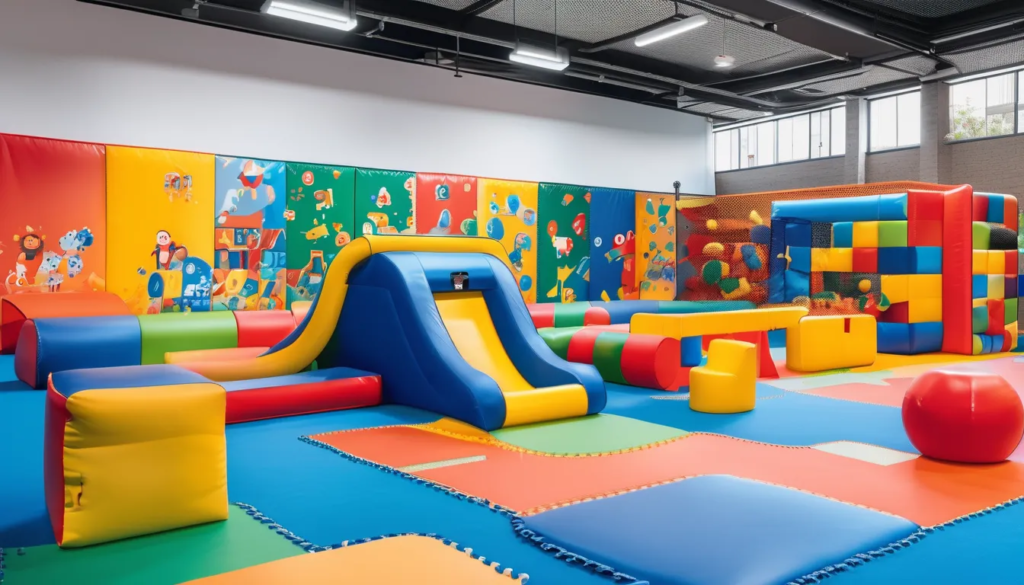
Did you know that children who engage in soft play activities are 30% more likely to develop essential motor skills by age three? Creating a safe and stimulating environment for little ones isn’t just beneficial; it’s crucial for their growth. You might wonder what elements are necessary to foster such an environment, or how you can effectively design a space that balances safety with exploration. Understanding these components can significantly enhance your approach to baby soft play.
Benefits of Baby Soft Play
Engaging in baby soft play offers countless benefits that contribute to a child’s overall development. You’ll find that these activities not only entertain but also stimulate critical physical and cognitive skills. As your little one crawls, climbs, and explores, they’re gaining strength, coordination, and balance. These fundamental motor skills lay the groundwork for more complex physical activities as they grow.
Moreover, soft play encourages sensory exploration. Your baby gets to feel various textures, colors, and shapes, enhancing their sensory development. This exploration fosters curiosity and creativity, which are essential for cognitive growth.
Social interaction is another significant benefit. When your child plays alongside other little ones, they learn vital social skills like sharing, taking turns, and communicating. These interactions build their emotional intelligence and help them form relationships, setting the stage for future social experiences.
Lastly, baby soft play reduces stress for both you and your child. It provides a safe environment where your baby can freely express themselves, promoting a sense of security.
Designing a Safe Play Area
Creating a safe play area for your baby is essential for their enjoyment soft play Australia development. Start by choosing a designated space free from sharp edges, heavy furniture, or fragile items. A clear, open area allows your little one to explore without the risk of injury.
Next, consider the flooring. Soft, cushioned surfaces like foam mats or carpets can help absorb falls. Ensure that any rugs are non-slip to prevent accidents.
You’ll want to keep the area well-lit, so you can easily supervise your baby as they play.
Remove any choking hazards by keeping small objects out of reach. If you have pets, make sure their toys or food are also stored away.
Additionally, baby-proof all electrical outlets and secure cords to avoid any entanglements.
Essential Soft Play Equipment
When setting up a baby soft play area, incorporating essential equipment can enhance your child’s experience and development.
Start with soft mats or foam tiles to create a safe surface for crawling and exploring. These provide cushioning and protect against falls, making them a must-have.
Next, consider soft play shapes like blocks, tunnels, and slides. These encourage climbing, crawling, and balancing, helping your little one develop motor skills. Opt for lightweight, colorful shapes that are easy for them to maneuver and stack.
Don’t forget about ball pits! They’re not only fun but also help with sensory development as children dive into a sea of soft balls. Ensure the balls are soft and safe for babies to avoid any hazards.
Additionally, including sensory toys like textured panels or mirrors can stimulate your baby’s curiosity and visual tracking.
Activities to Enhance Development
To enhance your baby’s development in a soft play area, incorporate a variety of activities that stimulate their physical, cognitive, and sensory skills.
Start with climbing structures, which encourage your little one to develop strength and coordination. As they navigate different heights, they’ll boost their confidence and balance.
Next, set up sensory stations featuring soft textures, colorful toys, and noise-making objects. This sensory exploration helps improve their fine motor skills and cognitive abilities.
Encourage them to reach, grasp, and manipulate items, which enhances hand-eye coordination.
You can also introduce simple games like peek-a-boo or rolling balls. These activities promote social interaction and understanding of cause and effect.
Singing songs or reading stories while playing will foster language development and listening skills.
Tips for Maintenance and Safety
Maintaining a safe and clean soft play area is just as important as the activities you offer for your baby’s development. Regular maintenance ensures your little one can explore freely without the risk of injury or illness. Start by inspecting the play equipment daily for any damage or wear. If you spot anything, fix or replace it immediately.
Next, establish a cleaning routine. Use non-toxic cleaners to wipe down surfaces and toys, keeping them germ-free. It’s also wise to sanitize items that come into contact with drool or food regularly.
Here’s a quick reference table to help you stay on track:
| Maintenance Task | Frequency |
|---|---|
| Inspect equipment | Daily |
| Clean surfaces and toys | After each use |
| Deep clean soft play area | Weekly |
| Replace damaged items | As needed |
| Check safety standards | Monthly |
Conclusion
In the world of baby soft play, “play is the highest form of research.” By creating a safe and stimulating environment, you’re not just providing a space for fun; you’re nurturing your little one’s development. Remember to regularly maintain the area and keep safety measures in place. With the right equipment and activities, you can inspire exploration and growth, helping your child thrive. Embrace this journey of discovery together—it’s a vital step in their early years!




